The Graphic and Shakespeare's Heroines
The weekly newspaper the Graphic commissioned twenty-one studies of Shakespeare's heroines that were exhibited in London in 1888. The Graphic frequently published pictures of beautiful women--under the inspirational guise of "ideal beauty"--and had previously commissioned a number of English artists "to portray his idea of female beauty." The review in the Art Journal of 1889 suggests that it was the success of this earlier venture that "prompted them to elicit once more the opinions of our artists upon the subject; this time, however, narrowing the selection to the HEROINES OF SHAKESPEARE" (51:95).
The Art Journal was not enthusiastic about Shakespeare's Heroines; first of all, the reviewer questions the way in which the project was conceived:
Now to commission an artist to paint a picture is usually a dangerous proceeding, so far as a successful result is concerned; still more so is it when the subject is not of his own selection; for an artist of talent cannot conjure up his visions at will, or upon the spur of the moment say that such and such are the lineaments with which he would portray his Juliet or his Cordelia; hence it is that one so often finds that the result is merely a dressing up in a new garb of the most attractive model obtainable at the moment. When the completed "studies," as they are called, of the Heroines, were shown last year in London, this was certainly apparent in more than one instance (96).
Although in the reviewer's opinion a few of the paintings are satisfactory, the entire exhibition and the reproductions published by Sampson Low & Co. do not meet a high standard:
Twenty-one ideal portraits are given by as many of our principal painters. The President of the Academy [Frederick Leighton] has selected Desdemona; Mr. Alma Tadema, Portia (wife of Brutus); and Mrs. Alma Tadema, Katherine of France. The most entirely satisfactory renderings seem to be Mr. Woods's Portia, Mr. Phil. Morris's Audrey, and Mr. Prinsep's Mariana; but it is evident that in many cases the pictures have suffered at the hands of the reproducers, for Mr. Calderon, for instance, could never have given to Juliet the dirty hands which here she displays, or Mr. Perugini have modelled such a cheek and neck as his Silvia possesses; the consort of Brutus, too, is decked in the sootiest of garments, and her figure retreats behind the trees which are many yards away. The process has been more fortunate in other cases, but it is never worthy of the house whose name it bears (96).
Accompanying each portrait is a brief narrative outline of the play written by William Ernest Henley (1849-1903). The texts are mere plot summaries, detached from the portraits, and the reviewer notes that this is a serious flaw in the project:
Mr. W. E. Henley in the descriptive letter-press has not only avoided criticism upon the illustrations, but does not even give us a hint as to what scene each aims at illustrating; this he explains is at the wish of those who commissioned him: we think his share in the work would have been more interesting had he had access to the painters, and given us their ideas upon the subject (96).
The copy reviewed in the Art Journal was reproduced in color (as are the pictures in Shakespeare Illustrated), but less expensive editions were published with black and white engravings. The complete series I examined at the Mudd Library of Yale University was published in 1888 by the Boston firm of Estes and Lauriat. This series is divided into five hardboard portfolios, each prefaced by an engraving of the one of the famous portraits of Shakespeare. The lack of detail by the author Henley is remedied somewhat in this edition by an act and scene number and a few lines of poetry to indicate the part of the play each picture illustrates and to give us a context for the portrait.
Section I
Section II
Section III
Section IV
Section V
 These pictures in Shakespeare's Heroines are in the tradition of the "keepsake," portraits of beautiful women, usually suitable for framing, that were popular with the Victorian public. Julian Treuherz says this "keepsake style" was "named after The Keepsake, a series of annual volumes published between the 1820s and 40s, containing light verse and sentimental stories illustrated with steel engravings, often of ladies in elegant costume, with fashionable ringlets and come-hither expressions, a formula often employed in cabinet pictures (intended for small rooms) and portraits" (22). The influence of these keepsakes is evident in many paintings of women--from Rossetti to Alma-Tadema--and in portraits in popular newspapers and periodicals like the Graphic long after the original publication faded.
These pictures in Shakespeare's Heroines are in the tradition of the "keepsake," portraits of beautiful women, usually suitable for framing, that were popular with the Victorian public. Julian Treuherz says this "keepsake style" was "named after The Keepsake, a series of annual volumes published between the 1820s and 40s, containing light verse and sentimental stories illustrated with steel engravings, often of ladies in elegant costume, with fashionable ringlets and come-hither expressions, a formula often employed in cabinet pictures (intended for small rooms) and portraits" (22). The influence of these keepsakes is evident in many paintings of women--from Rossetti to Alma-Tadema--and in portraits in popular newspapers and periodicals like the Graphic long after the original publication faded.
 The portraits of the Graphic reveal as well an aspect of what Nina Auerbach in Woman and the Demon (210-13) calls the "worshipful cult" of Shakespeare's women. She first cites John Ruskin who says in his essay "Of Queens' Gardens" that Shakespeare testifies to "the position and character of women in human life. He represents them as infallibly faithful and wise counsellors--incorruptibly just and pure examples,--strong always to sanctify, even when they cannot save." Auerbach insists that Ruskin does not exaggerate when he pays homage to a popular literary tradition of his age, in which women writers "extract Shakespeare's heroines from their plays and exalt them as womanhood's inspiration." She discusses two popular and influential Victorian works on Shakespeare, Anna Jameson's Shakespeare's Heroines (1832) and Mary Cowden Clarke's The Girlhood of Shakespeare's Heroines (1851).
The portraits of the Graphic reveal as well an aspect of what Nina Auerbach in Woman and the Demon (210-13) calls the "worshipful cult" of Shakespeare's women. She first cites John Ruskin who says in his essay "Of Queens' Gardens" that Shakespeare testifies to "the position and character of women in human life. He represents them as infallibly faithful and wise counsellors--incorruptibly just and pure examples,--strong always to sanctify, even when they cannot save." Auerbach insists that Ruskin does not exaggerate when he pays homage to a popular literary tradition of his age, in which women writers "extract Shakespeare's heroines from their plays and exalt them as womanhood's inspiration." She discusses two popular and influential Victorian works on Shakespeare, Anna Jameson's Shakespeare's Heroines (1832) and Mary Cowden Clarke's The Girlhood of Shakespeare's Heroines (1851).
 Jameson examines Shakespeare's women in three categories, the "moral," "poetical" and "historical," discussing and expanding upon their characters as if they might have an existence outside the drama. The result, Auerbach concludes, is that "Jameson's colony of mythic women frees its heroines from the plays." Clarke goes even further in The Girlhood of Shakespeare's Heroines by creating in fifteen chapters the early biographies of the women before we meet them in the plays. "More completely even than Jameson, Clarke frees the heroines from the boundaries of their plays, endowing them with rich lives of their own whose autonomy is impinged upon neither by Shakespeare nor the man his play will make them love" (212).
Jameson examines Shakespeare's women in three categories, the "moral," "poetical" and "historical," discussing and expanding upon their characters as if they might have an existence outside the drama. The result, Auerbach concludes, is that "Jameson's colony of mythic women frees its heroines from the plays." Clarke goes even further in The Girlhood of Shakespeare's Heroines by creating in fifteen chapters the early biographies of the women before we meet them in the plays. "More completely even than Jameson, Clarke frees the heroines from the boundaries of their plays, endowing them with rich lives of their own whose autonomy is impinged upon neither by Shakespeare nor the man his play will make them love" (212).
These twenty-one portraits of Shakespeare's heroines, published by the Graphic in 1888, thus perpetuate a uniquely Victorian tradition in art, literature and popular culture that elevates the women of the plays to idealized exemplars of feminine beauty and virtuous womanhood.
 The illustrations on this page are from Anna Jameson's Shakespeare's Heroines, published in 1901 by J. M. Dent (London) and E. P. Dutton (New York) as part of a series entitled "Miranda's Library." The illustrations are by R. Anning Bell. In this edition the heroines are divided into four categories: "Characters of Intellect," "Characters of Passion and Imagination," Characters of the Affections," and "Historical Characters." The book was originally published in 1832 (with a dedication to the actress Fanny Kemble), and this edition, reprinted almost seventy years later, proves its popularity and influence on both sides of the Atlantic--especially for the young readers of both America and Great Britain.
The illustrations on this page are from Anna Jameson's Shakespeare's Heroines, published in 1901 by J. M. Dent (London) and E. P. Dutton (New York) as part of a series entitled "Miranda's Library." The illustrations are by R. Anning Bell. In this edition the heroines are divided into four categories: "Characters of Intellect," "Characters of Passion and Imagination," Characters of the Affections," and "Historical Characters." The book was originally published in 1832 (with a dedication to the actress Fanny Kemble), and this edition, reprinted almost seventy years later, proves its popularity and influence on both sides of the Atlantic--especially for the young readers of both America and Great Britain.
 The portraits of the Graphic reveal as well an aspect of what Nina Auerbach in Woman and the Demon (210-13) calls the "worshipful cult" of Shakespeare's women. She first cites John Ruskin who says in his essay "Of Queens' Gardens" that Shakespeare testifies to "the position and character of women in human life. He represents them as infallibly faithful and wise counsellors--incorruptibly just and pure examples,--strong always to sanctify, even when they cannot save." Auerbach insists that Ruskin does not exaggerate when he pays homage to a popular literary tradition of his age, in which women writers "extract Shakespeare's heroines from their plays and exalt them as womanhood's inspiration." She discusses two popular and influential Victorian works on Shakespeare, Anna Jameson's Shakespeare's Heroines (1832) and Mary Cowden Clarke's The Girlhood of Shakespeare's Heroines (1851).
The portraits of the Graphic reveal as well an aspect of what Nina Auerbach in Woman and the Demon (210-13) calls the "worshipful cult" of Shakespeare's women. She first cites John Ruskin who says in his essay "Of Queens' Gardens" that Shakespeare testifies to "the position and character of women in human life. He represents them as infallibly faithful and wise counsellors--incorruptibly just and pure examples,--strong always to sanctify, even when they cannot save." Auerbach insists that Ruskin does not exaggerate when he pays homage to a popular literary tradition of his age, in which women writers "extract Shakespeare's heroines from their plays and exalt them as womanhood's inspiration." She discusses two popular and influential Victorian works on Shakespeare, Anna Jameson's Shakespeare's Heroines (1832) and Mary Cowden Clarke's The Girlhood of Shakespeare's Heroines (1851). These pictures in Shakespeare's Heroines are in the tradition of the "keepsake," portraits of beautiful women, usually suitable for framing, that were popular with the Victorian public. Julian Treuherz says this "keepsake style" was "named after The Keepsake, a series of annual volumes published between the 1820s and 40s, containing light verse and sentimental stories illustrated with steel engravings, often of ladies in elegant costume, with fashionable ringlets and come-hither expressions, a formula often employed in cabinet pictures (intended for small rooms) and portraits" (22). The influence of these keepsakes is evident in many paintings of women--from Rossetti to Alma-Tadema--and in portraits in popular newspapers and periodicals like the Graphic long after the original publication faded.
These pictures in Shakespeare's Heroines are in the tradition of the "keepsake," portraits of beautiful women, usually suitable for framing, that were popular with the Victorian public. Julian Treuherz says this "keepsake style" was "named after The Keepsake, a series of annual volumes published between the 1820s and 40s, containing light verse and sentimental stories illustrated with steel engravings, often of ladies in elegant costume, with fashionable ringlets and come-hither expressions, a formula often employed in cabinet pictures (intended for small rooms) and portraits" (22). The influence of these keepsakes is evident in many paintings of women--from Rossetti to Alma-Tadema--and in portraits in popular newspapers and periodicals like the Graphic long after the original publication faded. Jameson examines Shakespeare's women in three categories, the "moral," "poetical" and "historical," discussing and expanding upon their characters as if they might have an existence outside the drama. The result, Auerbach concludes, is that "Jameson's colony of mythic women frees its heroines from the plays." Clarke goes even further in The Girlhood of Shakespeare's Heroines by creating in fifteen chapters the early biographies of the women before we meet them in the plays. "More completely even than Jameson, Clarke frees the heroines from the boundaries of their plays, endowing them with rich lives of their own whose autonomy is impinged upon neither by Shakespeare nor the man his play will make them love" (212).
Jameson examines Shakespeare's women in three categories, the "moral," "poetical" and "historical," discussing and expanding upon their characters as if they might have an existence outside the drama. The result, Auerbach concludes, is that "Jameson's colony of mythic women frees its heroines from the plays." Clarke goes even further in The Girlhood of Shakespeare's Heroines by creating in fifteen chapters the early biographies of the women before we meet them in the plays. "More completely even than Jameson, Clarke frees the heroines from the boundaries of their plays, endowing them with rich lives of their own whose autonomy is impinged upon neither by Shakespeare nor the man his play will make them love" (212). The illustrations on this page are from Anna Jameson's Shakespeare's Heroines, published in 1901 by J. M. Dent (London) and E. P. Dutton (New York) as part of a series entitled "Miranda's Library." The illustrations are by R. Anning Bell. In this edition the heroines are divided into four categories: "Characters of Intellect," "Characters of Passion and Imagination," Characters of the Affections," and "Historical Characters." The book was originally published in 1832 (with a dedication to the actress Fanny Kemble), and this edition, reprinted almost seventy years later, proves its popularity and influence on both sides of the Atlantic--especially for the young readers of both America and Great Britain.
The illustrations on this page are from Anna Jameson's Shakespeare's Heroines, published in 1901 by J. M. Dent (London) and E. P. Dutton (New York) as part of a series entitled "Miranda's Library." The illustrations are by R. Anning Bell. In this edition the heroines are divided into four categories: "Characters of Intellect," "Characters of Passion and Imagination," Characters of the Affections," and "Historical Characters." The book was originally published in 1832 (with a dedication to the actress Fanny Kemble), and this edition, reprinted almost seventy years later, proves its popularity and influence on both sides of the Atlantic--especially for the young readers of both America and Great Britain.